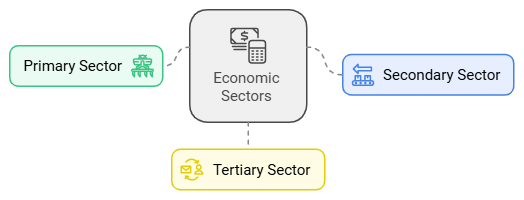Class 10 Exam > Class 10 Notes > Social Studies (SST) Class 10 > NCERT Summary: Sectors of the Indian Economy
Sectors of the Indian Economy Summary Class 10 Social Science Chapter 2
Economic Activities
- Economic activities are actions that create income. For instance, a computer engineer who develops software for profit is earning money from his work.
- Division of Economic Activities:

- Primary sectors: related to farming activities.
- Secondary sectors: related to manufacturing.
- Tertiary sector: provide support to the other two sectors.
Comparison of three sectors of the Economy (Through productivity and population)
- As thousands of economic activities are going around in all the three sectors, it makes almost impossible to take account of every such activity.
- We check only final goods and services.
- For example, a farmer who sells wheat to a flour mill for Rs 8 per kg.
- The mill grinds the wheat and sells the flour to a biscuit company for Rs 10 per kg.
- The biscuit company uses the flour and things such as sugar and oil to make four packets of biscuits.
- It sells biscuit in the market to the consumers for Rs 60 (Rs 15 per packet).
- Biscuits are the final goods, i.e., goods that reach the consumers.
Gross Domestic Product (GDP)
- The value of final goods and services produced in each sector during a particular year provides the total production of the sector for that year. And the sum of production in the three sectors gives what is called the Gross Domestic Product (GDP) of a country.
- It is the value of all final goods and services produced within a country during a particular year.
- GDP shows how big the economy is.
Historical Changes in sectors
- At initial stages of development, primary sector was the most important sector of economic activity in a country.
- With the innovation in farming methods, agriculture sector began to produce much more food than before.
- People started working in industries.
- Some people also got involved in transportation.
- Gradually, Secondary sector became the most important in economy and providing employment.
- Different industries related to food processing, equipment making, textiles started coming in large numbers.
- This led to start of services such as banking, health, education etc.
- The service sector has become the most important sector in terms of total production and started employing more people.
Contribution in GDP
- In India, the enormous task of measuring GDP is managed by a central government ministry.
- This ministry, along with various government departments from all Indian states and union territories, gathers data on the total volume of goods and services and their prices to estimate the GDP.
Factors behind the shift in contribution in GDP
- In the years 1973-74, the primary sector was the largest contributor to GDP. By 2013-14, the tertiary sector took the lead, outpacing the primary sector. This raises the question: why did this change occur? There are several reasons for this transformation.
- The growth of agriculture and industry has led to an increase in services like transport, trade, storage, and banking.
- As the primary and secondary sectors develop, the demand for these services rises.
Where are most of the people employed?
- In 1973-74, the primary sector contributed 40% to GDP, the secondary sector just 12%, and the tertiary sector 48%. Employment statistics from 1972-73 indicated that 74% of the Indian workforce was in the primary sector, while only 15% worked in the tertiary sector.
- By 2013-14, the tertiary sector's share of GDP had risen significantly, while the primary sector's share fell to just 12%. Notably, although the GDP shares of these sectors have changed, employment has not shifted in the same way. The primary sector remains the largest employer today.
- Even with the growth of the tertiary sector, there were not enough jobs created in the secondary and tertiary sectors, which is a major reason why employment in the primary sector has not decreased.
Disguised Unemployment
- This kind of underemployment is hidden in contrast to someone who does not have a job and is clearly visible as unemployed, it is also called disguised unemployment.
- For example: More people engaged in agriculture than the necessity.
How to create employment?
- Irrigation and Marketing Facilities: Providing irrigation facilities, such as constructing wells, can significantly enhance agricultural productivity. This, in turn, can lead to increased employment opportunities in farming.
- Investing in Infrastructure: Building infrastructure, such as dams and roads, is crucial for economic development and job creation.
- Promoting Small Scale Industries: Supporting small-scale industries, such as mills and honey collection centres, can generate local employment.
- Emphasis on Education and Training: Establishing education and training centres can equip the workforce with necessary skills, enhancing employability.
- Identifying Potential of Areas: Recognising and developing areas with potential, such as tourist sites, can create new job opportunities.
- Government Welfare Schemes: Implementing schemes like providing electricity, building hospitals, and constructing wells or pumps near farms can improve living standards and create jobs.
MGNREGA
- The central government in India made a law implementing the Right to Work in 625 districts called Mahatma Gandhi National Rural Employment Guarantee Act 2005 known as MGNREGA 2005.
- Under MGNREGA 2005:
In rural areas, all those who are able to, and are in need of work are guaranteed 100 days of employment in a year by the government.
If the government fails in its duty to provide employment, it will give unemployment allowances to the people.
Difference between Organised and unorganised sectors
- Organised sector workers are registered by the government and must adhere to its rules and regulations, whereas the unorganised sector generally operates outside of government oversight.
- Workers in the organised sector benefit from job security, while those in the unorganised sector do not have this assurance.
- Employees in the organised sector are required to work only a set number of hours. If they exceed this limit, they must be compensated with overtime pay.
- Organised sector workers receive benefits such as paid leave, holiday pay, a provident fund, gratuity, medical benefits, and other entitlements, which are typically absent in the unorganised sector.
- They are entitled to medical benefits, and the factory manager is responsible for providing facilities such as drinking water and a safe working environment.
- Upon retirement, these workers are eligible for pensions as well.
- Examples of the organised sector include government employees and banks, while examples of the unorganised sector encompass a headload worker carrying cement in a market, a farmer watering her field, and a daily wage labourer working for a contractor.
Classification of Economic activities into sectors (on the basis of who owns assets and is responsible for the delivery of services)
Activities can be classified into two types:
- Public sector:
- The government owns most of the assets and provides all the services.
- Example: Railways or post office
- Private sector:
- Ownership of assets and delivery of services is in the hands of private individuals or companies.
- Example: Tata Iron and Steel Company Limited (TISCO) or Reliance Industries Limited (RIL).
The document Sectors of the Indian Economy Summary Class 10 Social Science Chapter 2 is a part of the Class 10 Course Social Studies (SST) Class 10.
All you need of Class 10 at this link: Class 10
|
66 videos|798 docs|79 tests
|
FAQs on Sectors of the Indian Economy Summary Class 10 Social Science Chapter 2
| 1. भारतीय अर्थव्यवस्था के क्षेत्रों को कैसे वर्गीकृत किया जा सकता है? |  |
Ans. भारतीय अर्थव्यवस्था को तीन मुख्य क्षेत्रों में वर्गीकृत किया जा सकता है: प्राथमिक क्षेत्र (कृषि, खनन), द्वितीयक क्षेत्र (उद्योग, निर्माण) और तृतीयक क्षेत्र (सेवाएं, व्यापार)। ये क्षेत्र एक-दूसरे से जुड़े हुए हैं और आर्थिक विकास में महत्वपूर्ण भूमिका निभाते हैं।
| 2. प्राथमिक क्षेत्र की विशेषताएँ क्या हैं? |  |
Ans. प्राथमिक क्षेत्र का मुख्य कार्य प्राकृतिक संसाधनों का उपयोग करना है। इसमें कृषि, पशुपालन, मछली पालन, और खनन शामिल हैं। यह क्षेत्र रोजगार का एक बड़ा स्रोत है और देश की खाद्य सुरक्षा में महत्वपूर्ण भूमिका निभाता है।
| 3. द्वितीयक क्षेत्र का अर्थ क्या है और यह क्यों महत्वपूर्ण है? |  |
Ans. द्वितीयक क्षेत्र में औद्योगिक गतिविधियां शामिल होती हैं, जैसे कि निर्माण और प्रसंस्करण। यह क्षेत्र कच्चे माल को तैयार उत्पादों में परिवर्तित करता है और रोजगार के अवसर प्रदान करता है। यह आर्थिक विकास में योगदान देता है और देश की औद्योगिक नींव को मजबूत करता है।
| 4. तृतीयक क्षेत्र का क्या महत्व है? |  |
Ans. तृतीयक क्षेत्र सेवाओं से संबंधित है, जैसे कि बैंकिंग, शिक्षा, स्वास्थ्य, और पर्यटन। यह क्षेत्र आर्थिक विकास में तेजी लाने के लिए आवश्यक है क्योंकि यह उपभोक्ताओं की जरूरतों को पूरा करता है और रोजगार के अनेक अवसर प्रदान करता है।
| 5. क्या भारतीय अर्थव्यवस्था में इन तीनों क्षेत्रों का संतुलन महत्वपूर्ण है? |  |
Ans. हाँ, भारतीय अर्थव्यवस्था में इन तीनों क्षेत्रों का संतुलन बहुत महत्वपूर्ण है। तीनों क्षेत्रों का सामंजस्यपूर्ण विकास सुनिश्चित करता है कि देश की आर्थिक वृद्धि स्थायी और समावेशी हो, जिससे सभी वर्गों को लाभ मिल सके।
Related Searches






















